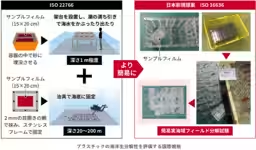

New ISO Standard Sets the Bar for Marine Biodegradable Plastics Evaluation Techniques
New ISO Standard for Evaluating Marine Biodegradable Plastics
In an initiative aimed at accelerating the adoption of marine biodegradable plastics, the new ISO 16636:2025 standard has been launched. This crucial guideline outlines field testing methods to assess biodegradability in real aquatic environments such as oceans, lakes, and rivers. Previously, testing methods required extensive infrastructure and specialized skills, highlighting the need for a more straightforward approach.
This groundbreaking standard facilitates the identification and assessment of marine biodegradable plastics by enabling tests without the need for elaborate setups. This significantly simplifies the process for researchers and encourages participation from a wider range of testing facilities. As a result, the efforts are expected to fuel the development and engagement of environmentally friendly plastic products in both Japan and across the globe.
Why This Standard Matters
The issue of marine plastic pollution has become increasingly dire, making the implementation of alternatives like marine biodegradable plastics essential. With the new ISO standard, scientists and researchers can evaluate how long these plastics remain intact and at what rate they degrade, providing critical insight into their ecological impact. Previously, standard ISO 22766 was available but utilized cumbersome methods which hindered practical applications in Japan.
By establishing a more accessible testing protocol, the new ISO 16636 allows for immersion testing in any freshwater or marine environment, which can significantly speed up the process of product approval and societal integration. This initiative is part of a larger project handled by the National Institute of Advanced Industrial Science and Technology (AIST) in collaboration with several academic institutions and governmental organizations aimed at advancing the practical application of marine biodegradable plastics.
Collaborative Efforts for Standard Development
The inception of this new standard involved collaboration between various institutions, including the AIST, the Japan BioPlastics Association (JBPA), Kobe University, and Kagoshima University, among others. Their collective efforts focused on creating a more effective assessment method that does not compromise on scientific rigor while remaining user-friendly.
The outcome was a method that uses simple immersion tests in floating containers, simulating marine conditions without the complexities of traditional methods. Researchers introduced new metrics for evaluating degradation rates that lessen the dependency on personal skill and experience, thus ensuring consistency and reliability in test results.
These developments are critical as the industry seeks to tackle pressing environmental issues associated with plastic waste. The quick yet systematic evaluation method establishes a framework for assessing the environmental behavior of these biodegradable plastics, allowing manufacturers to refine products that are less harmful to the environment.
Looking Ahead: Impact and Implementation
The future of biodegradable plastics stands to benefit tremendously from this new standard. By eliminating the need for complex setups, the standardized method is expected to be adopted not only in Europe and the United States but across various Asian countries, including Japan. This signifies a collective movement towards a more sustainable future in plastic usage.
The JBPA is evaluating how best to implement this new standard effectively within their identification system for marine biodegradable plastics. They are looking for ways to facilitate trials across multiple marine environments, ultimately resulting in a comprehensive service for simultaneous testing in diverse regions. Knowing the degradation rates can also aid in determining the ideal usage lifespan of these plastics within specific marine settings.
Additionally, an online seminar set for June 18 aims to educate stakeholders on the specifics of the new testing method, highlighting its potential benefits and application processes. This seminar will provide a platform for discussion and information sharing, promoting greater awareness and understanding in the field.
Conclusion
The issuance of ISO 16636:2025 is a critical development in the quest for reducing plastic pollution in our oceans. It empowers researchers and manufacturers to work collaboratively and efficiently towards a cleaner, more sustainable environment. With expectations for widespread adoption, it's a step forward in not only mitigating pollution but also fostering innovation in biodegradable materials. Stakeholders can expect this standard to pave the way for a new era in plastic production and usage, emphasizing the responsibility towards more sustainable practices.

Topics Consumer Products & Retail)










【About Using Articles】
You can freely use the title and article content by linking to the page where the article is posted.
※ Images cannot be used.
【About Links】
Links are free to use.